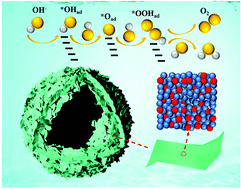A general MOF-intermediated synthesis of hollow CoFe-based trimetallic phosphides composed of ultrathin nanosheets for boosting water oxidation electrocatalysis†
Abstract
Engineering an electrode material for boosting reaction kinetics is highly desired for the oxygen evolution reaction (OER) in the anodic half reaction, and is still a grand challenge for energy conversion technologies. By taking inspiration from the catalytic properties of transition metal phosphides (TMPs) and metal–organic frameworks (MOFs), we herein propose a general MOF-intermediated synthesis of a series of hollow CoFeM (M = Bi, Ni, Mn, Cu, Ce, and Zn) trimetallic phosphides composed of ultrathin nanosheets as advanced electrocatalysts for the OER. A dramatic improvement of electrocatalytic performance toward the OER is observed for hollow CoFeM trimetallic phosphides compared to bimetallic CoFe phosphides. Remarkably, composition-optimized CoFeBiP hollow microspheres could deliver superior electrocatalytic performance, achieving a current density of 10 mA cm−2 with an overpotential of only 273 mV. Mechanistic investigations reveal that the Bi and P doping effectively optimizes the electronic structure of Co and Fe by charge redistribution, which significantly lowers the adsorption energy of oxygen intermediates. Moreover, the hollow microsphere structures composed of ultrathin nanosheets also enable them to provide rich surface active sites to boost the electrocatalytic OER.



 Please wait while we load your content...
Please wait while we load your content...